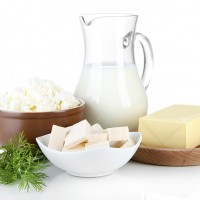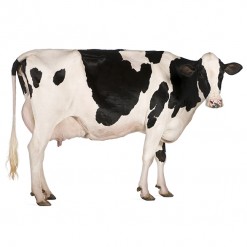

Lactose intolerance is when the body is not capable of digesting lactose, a sugar found in dairy products such as milk and cheese. It is different than a food allergy to milk, as people with lactose intolerance can sometimes drink small amounts dairy products without problems. Symptoms tend to develop in the teen years and are usually genetic. They can range from mild to severe, depending on how bad your intolerance is, and can include throwing up, gas, cramps, or bloating.
Lactose is a disaccharide sugar derived from glucose and galactose that is found in milk. It is extracted from sour or sweet whey, and the name comes from lactis, which is the Latin word for milk. Lactose is not added directly to many foods, because it is less soluble than other sugars. It is used frequently in the pharmaceutical industry, and is often added to pills as a filler because of its low price and compressibility.
 There are numerous reasons to go lactose-free. It could be because you are lactose intolerant or because you want to give it up for ethical reasons. People who have quit dairy sometimes encounter health problems such as ear infections, digestive problems, and chronic congestion. If you aren’t going lactose-free because of health reasons, you may want to test it out for a month first to see if your body can handle it. The key to going dairy-free is to not cut out all dairy products, but rather crowding them out with non-dairy alternatives. For example, instead of butter, eat vegan margarines. Instead of dairy yogurt, try soy yogurt. The biggest difficulty for most people is when it comes to finding a replacement for milk. There are many different types of milk, however, including coconut, almond, rice, and soy, and they are sold at almost all supermarkets. Milk products also show up frequently in baked goods. Luckily, there is a wide assortment of cookbooks available with excellent recipes for foods that usually contain milk-based ingredients. It can sometimes be difficult to go out for dinner when you are lactose intolerance. You need to pick your restaurant wisely – call ahead or look online to see if they will be able to accommodate your special diet restrictions. When you do order, always ask for the ingredients of the dish, and don’t be afraid to ask for changes to the menu (especially if you called ahead and confirmed that they would be able to do this). This is especially important if you are lactose intolerant, because you don’t want to get sick. Avoid eating fried foods if you can, as milk products can linger within coatings. Ideally, try to go Mediterranean, and order pasta dishes with olive oil- and tomato-based sauces, and dress your food lightly. If you are going lactose-free because of a personal choice, you should always consult your doctor or a nutritionist. Together, you can work out a meal plan that will keep you healthy but also help eliminate any and all dairy. Going lactose-free is certainly doable, as long as you are properly prepared!
There are numerous reasons to go lactose-free. It could be because you are lactose intolerant or because you want to give it up for ethical reasons. People who have quit dairy sometimes encounter health problems such as ear infections, digestive problems, and chronic congestion. If you aren’t going lactose-free because of health reasons, you may want to test it out for a month first to see if your body can handle it. The key to going dairy-free is to not cut out all dairy products, but rather crowding them out with non-dairy alternatives. For example, instead of butter, eat vegan margarines. Instead of dairy yogurt, try soy yogurt. The biggest difficulty for most people is when it comes to finding a replacement for milk. There are many different types of milk, however, including coconut, almond, rice, and soy, and they are sold at almost all supermarkets. Milk products also show up frequently in baked goods. Luckily, there is a wide assortment of cookbooks available with excellent recipes for foods that usually contain milk-based ingredients. It can sometimes be difficult to go out for dinner when you are lactose intolerance. You need to pick your restaurant wisely – call ahead or look online to see if they will be able to accommodate your special diet restrictions. When you do order, always ask for the ingredients of the dish, and don’t be afraid to ask for changes to the menu (especially if you called ahead and confirmed that they would be able to do this). This is especially important if you are lactose intolerant, because you don’t want to get sick. Avoid eating fried foods if you can, as milk products can linger within coatings. Ideally, try to go Mediterranean, and order pasta dishes with olive oil- and tomato-based sauces, and dress your food lightly. If you are going lactose-free because of a personal choice, you should always consult your doctor or a nutritionist. Together, you can work out a meal plan that will keep you healthy but also help eliminate any and all dairy. Going lactose-free is certainly doable, as long as you are properly prepared!
